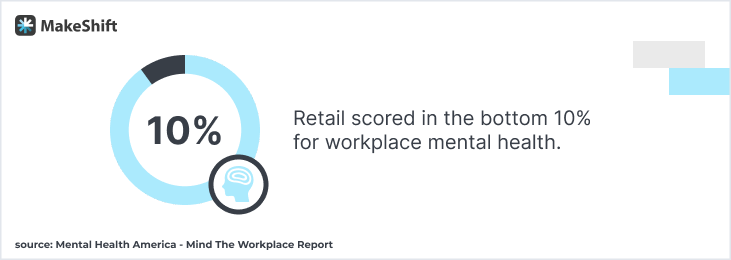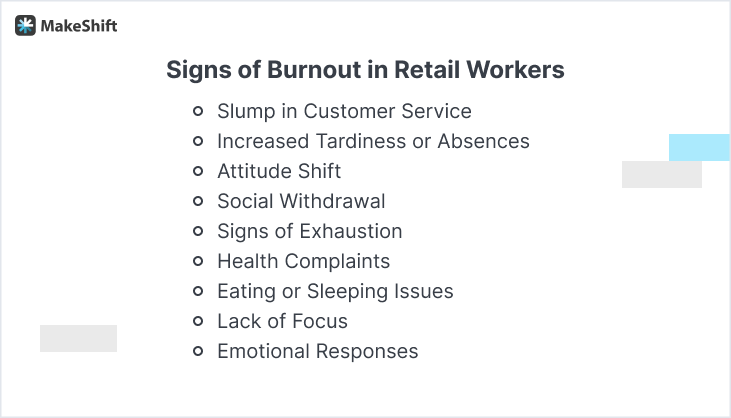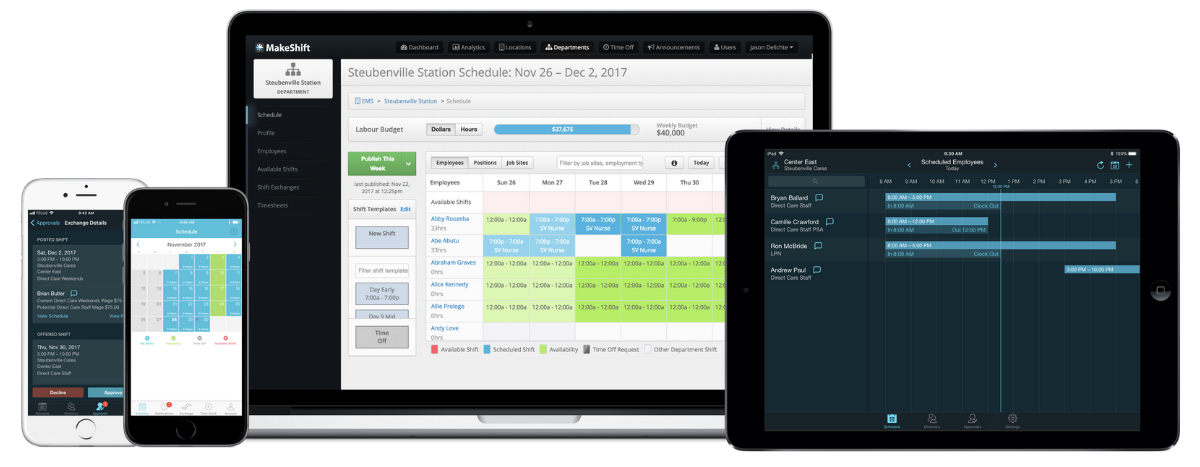Let’s talk about your retail store.
The aisles are busy, customers are buying, and your team is working hard to keep everything running smoothly.
But in the last couple of weeks, you’ve noticed something concerning.
Your employee, Drake, usually energetic and cheerful, seems to be dragging his feet, his smile forced.
You realize this might be more than a few bad days — it could be burnout.
This scenario is common in the fast-paced world of retail.
From overwhelming workloads to challenging customer interactions, retail workers face numerous stresses that can lead to mental and physical exhaustion, which can morph into burnout.
This article will help you understand and address retail worker burnout. We’ll explore the causes, signs, and, most importantly, the strategies to create a healthier, more sustainable work environment for your team.
- Retail Worker Mental Health Stats
- 13 Draining Factors Contributing To Retail Worker Burnout
- How to Spot Burnout in Your Retail Staff
- How To Approach a Retail Employee Showing Signs of Burnout
- 15 Strategies to Manage or Prevent Retail Worker Burnout
- FAQs
- MakeShift Can Help Head Off Retail Staff Burnout
Retail Worker Mental Health Stats
The retail sector is grappling with an alarming trend — escalating mental health issues among its workforce. Retail worker burnout is prevalent today.
- Retail scored in the bottom 10% for workplace mental health.

- 84% of retail workers report declining mental health in recent years.
- More than half (59%) of all American workers are experiencing at least moderate levels of burnout.
- 1 in 4 retail workers reported high on-the-job anxiety.
- Workers with the most financial instability experience the highest rate of burnout.
- The quit rate for retail workers is more than 70% higher than in other US industries.
- 41% of retail workers say customer stress has made them cry.
13 Draining Factors Contributing To Retail Worker Burnout
Retail jobs can be mentally draining due to various factors. Understanding these factors is crucial to creating a more supportive work environment.
We’ve compiled a list of the top 13 “drainers”:
1. Crazy hours
Retail employees often work long hours, including weekends, evenings, and holidays. Long work hours and unpredictable schedules can disrupt their work-life balance and lead to mental fatigue.
2. Customer tsunamis
Dealing with a steady stream of customers, especially during peak seasons or sales, can be overwhelming. Managing a wide range of personalities and demands requires constant mental engagement and patience.
3. Emotional tax
Retail workers frequently have to display positive emotions and suppress negative ones, regardless of their actual feelings. This "emotional labor" is mentally exhausting and can lead to burnout.
4. Their dogs are barking
Being on their feet for extended periods, managing stock, and maintaining store presentation contribute to physical fatigue, affecting mental health.
5. Repetitive humdrum
Engaging in repetitive tasks without much variation can lead to boredom and a sense of monotony, which can be mentally draining.
6. Lack of voice
Many retail jobs offer limited autonomy and involve mundane, monotonous tasks. Lack of control and variety in work can lead to less job enjoyment and mental strain.
7. Gladiator-like customers
Interactions with difficult or irate customers can be stressful and an energy drain. Retail workers must be able to manage conflict and maintain professionalism under pressure, and that takes a toll over time.
8. Sales pressure cooker
Sales targets and performance metrics can create constant pressure, leading to anxiety and stress, especially if these goals are perceived as unrealistic or unattainable.
9. Job insecurity
Many retail positions are characterized by low job security, part-time hours, poor shift planning, and minimal benefits, contributing to financial stress and uncertainty about the future.
10. Lack of career options
A job can feel pointless if there’s no room to grow. Limited opportunities for professional growth or advancement within the retail sector can lead to stagnation and a lack of motivation.
11. Not enough training and support
Insufficient training in handling complex situations, products, or customer service can leave employees feeling underprepared and stressed.
12. Workplace conflicts
Interpersonal issues with colleagues or management, including lack of support or workplace bullying, significantly contribute to mental strain.
13. Tech changes
Keeping up with new retail technology, like point-of-sale systems or inventory management software, can be challenging for some employees, adding to their stress.
How to Spot Burnout in Your Retail Staff
Recognizing these signs in your staff is crucial for timely intervention. You should approach these situations with understanding and provide appropriate support.
Support the well-being of your retail workers through:
- Schedule adjustments
- Additional training
- Professional help
- Paid time off
Watch for these signs of burnout in your retail staff

- A Slump in Customer Service — If an ordinarily enthusiastic and customer-focused employee starts showing signs of indifference or frustration in customer interactions, it could be a sign of burnout.
- Increased Tardiness or Absences — Regular lateness or an uptick in calling out sick, especially if this is out of character.
- A Shift in Attitude Towards Work — Changes like a retail employee becoming cynical about customers or expressing excessive negativity towards the job can be signs of emotional exhaustion.
- Social Withdrawal on the Job — If an employee who used to engage with coworkers during breaks or contribute to team meetings becomes withdrawn or disinterested, it might signal burnout.
- Visible Signs of Exhaustion — Persistent tiredness, yawning frequently, looking physically drained, or complaining of being tired all the time can be physical manifestations of burnout.
- Health Complaints — Frequent mentions of headaches, muscle pain, or feeling unwell can be stress-related and signs of burnout.
- Eating or Sleeping Issues — Changes in appetite or sleep patterns, like skipping meals or mentioning trouble sleeping, are often associated with high stress and burnout.
- Difficulty Focusing — If an employee starts making uncharacteristic mistakes at the register, forgets protocols, or has trouble staying focused, it could be a sign of mental overwhelm.
- Emotional Responses — Unusual emotional reactions, such as overreacting to minor issues, seeming overly sensitive, agitation, or tearfulness, can be red flags for burnout in retail employees.
How To Approach a Retail Employee Showing Signs of Burnout
Approaching a retail employee showing signs of exhaustion and burnout should be done with care and empathy.
Initiate the conversation in a private setting and express concern for their well-being.
Listen actively and empathetically to their concerns, acknowledging their hard work.
Discuss possible solutions like:
- Temporarily adjusting their workload
- Offer employee resources like employee assistance programs
- Encourage them to take time off if they need it
Reassure your employee — their health is a priority and their feelings are valid.
The aim is to make them feel supported and find ways to collaboratively alleviate their stress.
15 Strategies to Manage or Prevent Retail Worker Burnout
Spotting the signs of burnout is important. However, a more proactive approach is to prevent retail employee burnout in the first place.
Retail work can be exhausting, but there are ways to counteract this industry's mental and physical strain.
1. Orchestrate team harmony with people-first staffing & scheduling
Regularly assess staffing needs, especially during peak seasons. Use staff scheduling software to manage shift rotations and avoid overworking employees.
Implement a scheduling system where employees can set their availability, ensuring coverage during busy times while respecting personal time.
Consider hiring temp staff during high-demand seasons like holidays.
2. Pause for peace — The power of regular breaks
Enforce mandatory break policies so your employees can disconnect from work.
Create a serene break room to rejuvenate. That might include healthy snacks, bottled water, and comfortable seating.
The stats about the power of breaks speak for themselves:
- 90% of employees believe regular breaks boost their mood.
- Two 15-minute breaks can improve employee productivity by 2.85 hours a week or 1.4 hours monthly.

Schedule staggered breaks to maintain store coverage while giving each employee their deserved rest time.
3. Empower knowledge with training & support
Conduct regular training sessions on product knowledge, customer service techniques, and stress management.
Pair new hires with mentors for on-the-job guidance to build competence and confidence.
Host monthly workshops where experienced employees share best practices and coping strategies for high-pressure situations.
4. Cultivate open heart, open door communication
Foster an environment where employees feel comfortable voicing concerns. Hold regular team meetings for open discussions.
Create an anonymous suggestion system to encourage candid feedback.
Use monthly meetings to address concerns, celebrate achievements, and discuss upcoming changes or challenges.
5. Dole out kudos with recognition & rewards
Implement recognition programs like “Employee of the Month” or “Top Salesperson.”
Employees love rewards like:
- Bonus incentives
- Gift cards
- Movie tickets
- Extra paid days off
You could also set up a bulletin board in the break room highlighting employee achievements.
6. Help them climb the ladder to success with career development opportunities
Do you have employees who want to grow with your company?
Let them know about career path options within the company and offer training or educational subsidies to encourage growth.
One way to do this: Create a program for employees to shadow different roles or departments, encouraging skill development and career progression.
7. Prioritize work-life balance
Implement policies that respect personal time, like avoiding contact on days off unless necessary.
Encourage employees to take their full vacation time.
Offer flexible scheduling or self-scheduling options so your retail staff can choose shifts that best fit their lives.
8. Give them comfy quarters to enhance the physical work environment
Invest in ergonomic equipment, maintain a comfortable store temp, and ensure good lighting.
Offer amenities like:
- Water dispensers & refillable water bottles
- Comfortable seating in break areas
- Place anti-fatigue mats at registers or other areas where employees stand for long periods.
9. Show that their mind matters & provide mental health support
Offer access to mental health resources like paid mental health days, counseling services, or wellness apps.
Organize workshops on stress management and mindfulness.
Partner with a mental health platform to offer employees free or discounted access to therapy sessions.
According to an APA report, providing employees access to mental health services can lead to a 33% decrease in absenteeism and a 22% reduction in healthcare costs.

10. Build team morale & cohesion
Organize team-building activities, both inside and outside the workplace.
Celebrate team successes and milestones.
Arrange a quarterly team outing, like a group lunch or a fun activity, to foster camaraderie.
11. Empower employees with freedom to flourish
Allow employees some degree of autonomy in decision-making for minor issues.
Encourage and reward initiative and creative solutions.
For example, let your employees handle certain customer service decisions, like processing minor returns or exchanges without your approval.
12. Get techy — Streamline workflows with tools
Invest in user-friendly tech for inventory management, sales processing, and staff scheduling. Streamline workflows to minimize stress during peak hours.
You could adopt a mobile point-of-sale system that allows retail employees to process transactions anywhere in the store, reducing customer wait times.
We also recommend using staff scheduling software so you and your staff can manage scheduling from your phones.
13. Give your team a voice by seeking & acting on feedback
Conduct quarterly surveys to get employee feedback on your workflows and implement feasible suggestions for improvement.
SurveyMonkey is an excellent tool for this. Not sure what questions to include?
Ask ChatGPT — we tried it, and here’s what ChatGPT gave us:

14. Train for difficult interactions & customer conundrums
Provide training on handling demanding customers, including de-escalation techniques like:
- Active listening
- Maintaining calm & keeping composure
- Empathize & validate
- Offer solutions
Lay out clear policies for when to call in management.
Try role-playing scenarios in training sessions to prep employees for challenging customer interactions.
15. Rotate roles to reduce monotony
Rotate employees through different roles or departments. Cross-training not only reduces boredom but also increases overall team flexibility.
Remember, proper training is a key element in the success of role rotation.
The most common ways to cross-train in an organization are:
On-the-job training — 65%.
Coaching or mentoring — 57%.
Job shadowing — 41%.
Switch employees between cashier, stock, and sales floor roles every few weeks to keep their work life enjoyable.
FAQs
What causes retail worker burnout?
Retail worker burnout is often caused by a combo of long hours, high-pressure environments, and repetitive tasks. Retail employees frequently face the challenge of dealing with difficult customers, which can be mentally draining.
In addition, the pressure to meet sales targets and perform consistently in a fast-paced environment can be stressful. Limited opportunities for career growth and a lack of control over their work schedules can also contribute to feelings of burnout among retail workers.
Why do retail workers quit?
Retail workers often quit their jobs for reasons like:
- Low pay
- Insufficient benefits
- Erratic work schedules
- Inadequate work-life balance
The demanding nature of retail work, which includes irregular hours, weekend and holiday shifts, plus extended periods of standing, can lead to physical and mental exhaustion.
Another significant factor is the retail industry's lack of career advancement opportunities, making employees feel stuck and undervalued.
Last but not least, a negative work environment, like poor management or lack of coworker support, can also drive retail workers to leave their jobs.
Is retail a high-stress job?
Yes, retail can be a high-stress job. Retail workers have to juggle various tasks such as:
- Managing inventory
- Assisting customers
- Handling transactions
- Maintaining store presentation
Dealing with a high volume of customers, especially during peak shopping seasons or sales, piles on the stress. Retail employees often work under pressure to meet sales targets and provide high-quality customer service.
The unpredictability of customer behavior and the need to handle complaints or difficult situations can also contribute to the stress experienced in retail jobs.
What is employee burnout in the retail industry?
Employee burnout in the retail industry refers to physical, emotional, and mental exhaustion from prolonged stress and overwork.
This can manifest as a lack of enthusiasm for the job, reduced efficiency, and disillusionment with work.
Retail employees experiencing burnout might show signs like decreased motivation, irritability, fatigue, and a sense of detachment from their job responsibilities. Burnout can be exacerbated by understaffing, unreasonably high expectations, and a lack of recognition or support from management.
How MakeShift Can Help Head Off Retail Staff Burnout
MakeShift was developed with a people-first approach to scheduling. Our solution cuts down on clunky, chaotic, time-consuming scheduling.
By prioritizing flexibility, communication, and efficiency, we help mitigate factors that contribute to employee burnout.
We streamline the scheduling process and empower employees with more control over their work schedules, leading to improved work-life balance and job satisfaction.
Our favorite benefits and features that combat burnout:
- User-Friendly Interface — Easy-to-use platform for both managers and employees. It simplifies the process of creating and adjusting schedules.

- Employee Empowerment — Employees can set their availability and request time off or swap shifts. Empower your employees and ease their stress by giving them a say in their work schedules.

- Real-Time Notifications — Instant updates on shift changes, approvals, time-tracking, or urgent messages. Keeps everyone informed, reducing confusion and last-minute rushes for a calmer workflow.

- AI-Powered Scheduling Platform — ShiftMate AI Offers 24/7 scheduling suggestions based on historical data & employee preference. Prevents understaffing or overstaffing, reducing employee workload stress.

- Mobile Accessibility — Accessible on smartphones, allowing for on-the-go schedule management. A schedule in their pocket enhances flexibility and convenience for both staff and managers.

- Integration — Can be integrated with payroll and HR systems for a seamless workflow. Reduces administrative burden and potential for scheduling errors.

Prevent Retail Worker Burnout Before It Starts
The retail industry will always be busy with fluctuating customer demands that can impact employees’ mental health.
However, you implement the proactive steps we’ve given you and help prevent burnout, which is the best way to manage it.
At MakeShift, we prioritize employee well-being and it shows in our smart, intuitive scheduling solution. Ready to see it in action? Schedule a demo today.








